The WaterSense Current Summer 2011
Issue XIX, Summer 2011:
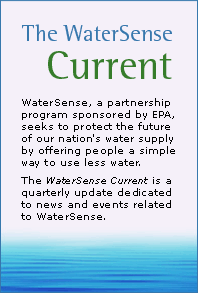 |
In This Issue: |
Niagara-Sized Savings
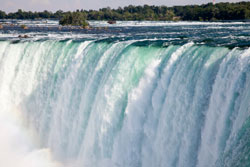
Since the program's inception in 2006, WaterSense and its partners have helped consumers save 125 billion gallons of water. That's equal to three days' flow over Niagara Falls! Over the last five years, WaterSense labeled products have also helped users reduce their water and energy bills by more than $2 billion, avoid greenhouse gas emissions equal to removing 1.2 million cars from the road, and save enough energy to power more than 1.5 million American homes for a year.
To honor WaterSense's fifth anniversary and recognize the importance of green innovation, EPA Administrator Lisa Jackson toured the Moen Incorporated plumbing fixture facility in North Olmstead, Ohio. Moen, the 2010 WaterSense Manufacturer Partner of the Year, is only one of the many WaterSense partners that helped make WaterSense's fifth year the best one yet!
2010 Annual Savings
- Almost 80 billion gallons of water
- 10.8 billion kilowatt hours of electricity
- $1.3 billion in water and energy bills
- 3.9 million metric tons of carbon dioxide equivalent
With the release of a showerhead specification in 2010, the full suite of WaterSense labeled bathroom products—toilet, faucet, showerhead—is now complete. A household updating its bathroom with WaterSense labeled fixtures could save enough water each year to wash six months' worth of laundry.
WaterSense also made progress on creating specifications for other water-saving products. EPA revised its draft specification for weather-based irrigation controllers and expects to release the final version in fall 2011. Additionally, WaterSense completed a study to evaluate the water savings and performance of water-efficient pre-rinse spray valves, which commercial kitchens use to rinse dishes. The first WaterSense labeled new homes were also completed in Roseville, California, by KB Home.
In 2010, WaterSense also launched the We're for Water campaign, which gives Americans simple ways to save water around the home. Flo, the We're for Water "spokesgallon," visited national landmarks and partner events to spread the word about water efficiency. Flo continues to promote the We're for Water campaign at events around the country and on the WaterSense Facebook page![]() .
.
Read more about WaterSense's 2010 accomplishments.
Things are Starting to Get Weird

Because WaterSense is committed to promoting water efficiency by raising awareness, we're excited to tell you about a new public service campaign, sponsored by a coalition of companies concerned about water conservation – including WaterSense partners Lowe's and Kohler. The campaign is called Wasting Water is Weird and is already running online – it will soon launch on television as well. It's a positive, humorous message delivered by a guy named Rip the Drip, who shows up just when using water becomes wasting water – and that's when things get weird.

Want to help? Check out the videos and meet Rip at www.wastingwaterisweird.com![]() . Go to Facebook and "Like" Rip the Drip. Follow him on Twitter @RipTheDrip. Then tell all your friends and family to do the same! Your role is vital to help bring attention to the issue and ultimately help change behavior for the better.
. Go to Facebook and "Like" Rip the Drip. Follow him on Twitter @RipTheDrip. Then tell all your friends and family to do the same! Your role is vital to help bring attention to the issue and ultimately help change behavior for the better.
Thanks for your help, and remember: Wasting Water is Weird.
We've Come a Long Way in Five Short Years
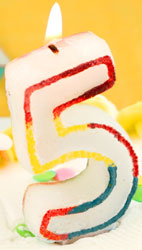
Over the last five years, WaterSense released six labeling specifications, grew to more than 2,200 partners, and campaigned to help Americans save water. As the program recognizes its fifth anniversary, WaterSense looks back on some of the water-saving advances of the past several decades.
Then: Remodelers and do-it-yourselfers hoarded water-hogging 3, 5, and even 7-gallon per flush toilets, because some of the first generation of low-flow toilets didn't always do the job on the first flush.
Now: You can flush with confidence because WaterSense labeled toilets are independently certified to perform as well as or better than standard models.
Then: Sinks in shades of avocado and "Pepto®" pink featured faucets that flowed between 3 and 5 gallons per minute, needlessly sending excess water and money down the drain.
Now: You can find WaterSense labeled faucets, available in a variety of modern styles and price points to match any bathroom décor, that will use 30 percent less water than today's standard models without a noticeable difference in flow.
Then: Low-flow showerheads could force users to take longer, less satisfying showers, cancelling out the water-saving benefits.
Now: You can shower with power while still saving water, because WaterSense conducted consumer testing to establish its performance criteria for labeled showerheads.
Then: Watering sidewalks and watering in the rain were commonplace water wasters. And planting a water-efficient yard meant sticking to cacti and rock gardens.
Now: You can use less water while helping to maintain beautiful, healthy landscapes by using professionals certified through WaterSense labeled programs to help design and maintain irrigation systems. In the future, you'll be able to find WaterSense labeled weather-based irrigation controllers that use local weather data to ensure you're not watering during rain showers.
Then: Even with a federal standard for flushing urinals that use just one gallon to flush, more than 65 percent of installed urinals could be using up to 5 gallons of water every time they flush.
Now: You can stand up for savings by installing WaterSense labeled flushing urinals that use at least 50 percent less water than the standard. Replacing just one inefficient urinal with a WaterSense labeled model can save a facility approximately 4,600 gallons of water per year.
Then: Homes filled with inefficient plumbing fixtures and appliances were prone to leaks.
Now: When compared to a traditional house, a WaterSense labeled new home can save your family of four up to 50,000 gallons of water per year—and that's just indoors. You would use that much water to shower for an entire decade!
Beat Your Summer Peak
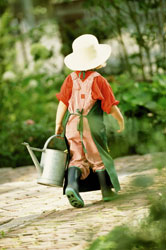
During dry summer months, outdoor water use increases, with more than 70 percent of water going to landscape irrigation in some areas of the country. This contributes to a phenomenon known as "peak water use season." Water use further increases on weekends, as many people use this free time to tend lawns and landscapes, wash cars, and do laundry—all high water-using tasks.
Before you put another drop of water on your yard this summer, remember: just because your grass looks dry, doesn't mean that watering more is the solution for a healthy landscape.
While the average American household uses about 260 gallons of water per day, during peak water use season, that amount can jump to 1,000 gallons per day. Some homes even use as much as 3,000 gallons of water on a peak day—the equivalent of leaving a garden hose running for nearly eight hours.
Here are some tips for efficient water use in the summer and year-round to ensure a healthy lawn even during drier periods.
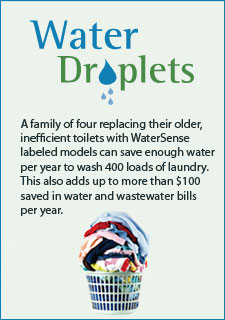
- Step on it: Grass doesn't always need water just because it's hot out. Step on the lawn, and if the grass springs back, then it doesn't need water. An inexpensive soil moisture sensor can also show the amount of moisture at the plant's roots and discourage overwatering.
- Time it right: It's best to water lawns and landscapes in the early morning and late evening, because significant amounts of water can be lost due to evaporation at other times of day. Check with your local utility to find out what times are best for your region.
- Tune-up your system: Inspect irrigation systems and check for leaks and broken or clogged sprinkler heads. Fix sprinkler heads that are broken or spraying on the street or driveway.
- Play zone defense: Assign areas of your landscape different zones depending on sun/shade exposure, soil and plant types, and type of sprinklers. Adjust your irrigation system or watering schedule based on those zones.
- Give your hose a break: Sweep driveways, sidewalks, and steps rather than hosing them off. And don't forget to check for leaks at your spigot connection and tighten as necessary.
- Leave it long: Raise your lawn mower blade. Longer grass promotes deeper root growth, resulting in a more drought-resistant lawn, reduced evaporation, and fewer weeds.
Although summer months are perhaps the time when homeowners think about water and their landscapes the most, a successful, well maintained landscape takes a year-round approach to water use. Adjust watering schedules and habits according to the season. Automatic irrigation systems should also be scheduled according to zones to account for the type of sprinkler, shade or sun exposure, and soil and plant type.
Learn more about how to beat your summer water peak and save water year round. You can also find a WaterSense irrigation partner in your area.
Q&A With WaterSense Partner Judy Benson
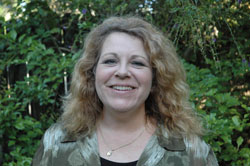
Judy Benson, founder of Clear Water Products and Services in Central Florida, was hot on water efficiency long before it was cool. With her focus on irrigation system renovation and dedication to water efficiency education, Benson has helped Florida residents save billions of gallons of water outdoors in the last decade. For these and other accomplishments, Benson was honored as the 2010 WaterSense Irrigation Partner of the Year.
WaterSense: Have you always been a proponent for outdoor water efficiency?
Benson: I began promoting efficiency in 2000, just as the need to conserve water was starting to be discussed with property owners. I see the importance of outdoor water efficiency beginning to increase with the implementation of voluntary green programs such as WaterSense.
WaterSense: Do you think most homeowners tend to overwater?
Benson: As a hobbyist gardener, it was fairly easy for me to identify that most people were overwatering without realizing that they were. After all, when you water in Florida, it just soaks into the ground with little to no puddles. I recall from many years ago a client who had just purchased an irrigation system and was receiving their water schedule recommendations who said, "Are you sure you're an irrigation contractor? Because I've never heard one tell me not to water before."
WaterSense: What are some of your best tips for homeowners?
Benson: Just because you walk across your lawn in bare feet and it feels dry, doesn't mean it needs more water. An inexpensive soil moisture sensor inserted down into the roots should give you a fairly accurate reading of the soil's water level. To make your watering go further, especially if you're in an area with restricted watering days, apply two-thirds of your water in the early morning and then top it off with the remaining one-third at night. This will help your lawn make it through a day or two with no water.
WaterSense: What are the positive effects of saving water outdoors?
Benson: Along with environmental benefits—saving dwindling resources, reducing runoff, and increasing overall plant health—using the appropriate amount of water outdoors can also help save on utility bills and lawn maintenance costs.
WaterSense: Why do you think promoting water efficiency outdoors is important?
Benson: Outdoor water use affects more than just the property that we are caring for; it affects the local environment. Runoff not only wastes water but burdens our stormwater systems that enter lakes, rivers, and eventually the ocean with lawn maintenance chemicals and fertilizers. When a water system is compromised we have technology to clean it, but that also leads to increased costs. Many of these surface water sources are providing drinking water to our homes and of course the local wildlife. Water is the one resource that we as living beings are unable to sustain ourselves without. I like to believe that I can help improve this situation just a bit by our continued efforts.
We Want Your Water-Saving Tips
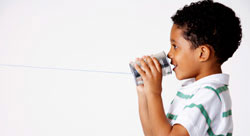
We know you have water-saving ideas, tips, and techniques of your own. Share them with other Current readers by emailing them to the WaterSense Helpline [e-mail link to watersense@epa.gov] with "WaterSense Tips" in the subject line. We look forward to including your contributions in the coming issues of the WaterSense Current or on WaterSense's Facebook page![]() .
.
Stop by and See Us Sometime
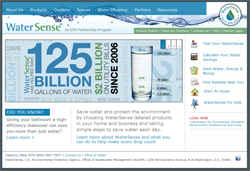
Visited the WaterSense website lately? It's chock full of water-saving tools and tips to help you take water efficiency into your own hands. Check them out:




